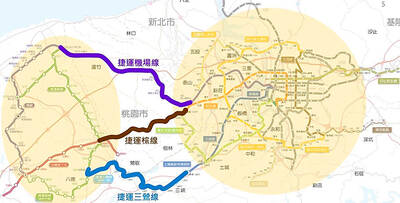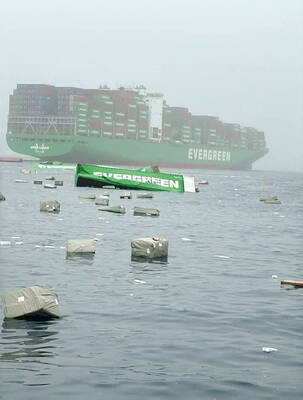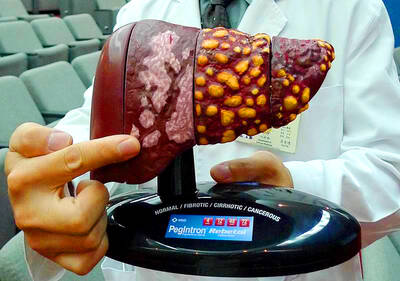Recent studies by Chiayi City's Health Bureau on the blood sugar, cholesterol and triglyceride levels of 3,730 students in their first year of junior high found that as many as 25.5 percent, or 952 students, had health problems.
Around 5 percent were overweight with above normal cholesterol levels. Some underweight students also had high cholesterol levels.
Tsai I-ching (蔡宜靜), a pediatrician at St. Martin de Porres Hospital, said the results are symptomatic of unhealthy diets and nutritional imbalance arising from modern eating habits, which often include regular meals at restaurants and fast-food chains.
The Ministry of Education said last year that 26.3 percent of Chiayi City's primary school children were overweight -- the highest in the country.
Chiayi City's Education Bureau has since drafted a health and weight management plan for school children, aimed at promoting exercise and a healthy diet.
It recommended that blood sugar, cholesterol and triglyceride levels be checked in all physical examinations for first year junior high school students.
The ministry commissioned medical personnel from a hospital in Chiayi to take blood samples at schools and analyze them. The results found that of the 3,730 first year junior high school students, 70 had high triglyceride levels.
The Chiayi City Health Bureau suspected metabolic problems and recommended the students seek medical treatment.
Of the three indicators, students with high cholesterol numbered the highest, with 861 students. The student with the highest cholesterol level had 286 milligrams per deciliter.
Twenty-one students had abnormal blood sugar levels, which can be reduced by changing eating habits, the bureau said.
The bureau blamed the health problems on unbalanced diets and a lack of exercise, often leading to obesity, and on hereditary factors.
The study found that students with high cholesterol were not necessarily overweight. Many of those with high levels were of average weight or underweight.
Tsai said that high readings of these three indicators are new to children, and previously almost exclusively seen in middle-aged people and older.
The results of the Chiayi study shocked experts, who believe it reflects society's change in diet.
While high cholesterol in overweight students is caused by obesity, in underweight students, it is a result of nutritional imbalances, Tsai said.
Meanwhile, a study on obesity and related illnesses commissioned by the Department of Health and conducted by Jhu Nian-fong (祝年豐), former chairman of the Taiwan Medical Association for the Study of Obesity and Director-General of the Taichung County Department of Health, found that one in every three boys and one in every four girls are overweight or obese.
Jhu said urban children eat too much fast food and drink too many soft drinks, which are high in sugar and calories, while those in mountainous regions or outlying islands have gone from being undernourished, to consuming too many fatty meats.
Chang Mei-hwei (張美惠), pediatrics professor at National Taiwan University and convener of a special research group on children's health under the Children's Health Commission, said weight control should begin with toddlers.
Children who are obese have a 42 percent to 63 percent chance of becoming obese in adulthood, she said, adding that parents should stop over-feeding children because they think chubbiness is cute.

The Executive Yuan yesterday approved a southwestern extension of the Sanying MRT Line from New Taipei to Bade District (八德) in Taoyuan, with a goal of starting construction by late 2026. The 4.03-kilometer extension, featuring three new stations, will run from the current terminus at Yingtao Fude Station (LB12) in New Taipei City to Dannan Station (LB14), where it will connect with Taoyuan’s Green Line, New Taipei City Metro Corp said in a statement. This extension will follow the completion of core Sanying Line, a 14.29-kilometer medium-capacity system linking Tucheng (土城), Sansia (三峽)

CARGO LOSS: About 50 containers at the stern of the ‘Ever Lunar’ cargo ship went overboard, prompting the temporary closure of the port and disrupting operations Evergreen Marine Corp, Taiwan’s largest container shipper, yesterday said that all crew members aboard the Ever Lunar (長月) were safe after dozens of containers fell overboard off the coast of Peru the previous day. The incident occurred at 9:40am on Friday as the Ever Lunar was anchored and waiting to enter the Port of Callao when it suddenly experienced severe rolling, Evergreen said in a statement. The rolling, which caused the containers to fall, might have been caused by factors including a tsunami triggered by an earthquake in Russia, poor winter sea conditions in South America or a sudden influx of waves,

The Ministry of Culture yesterday officially launched the “We TAIWAN” cultural program on Osaka’s Nakanoshima sandbank, with the program’s mascot receiving overwhelming popularity. The cultural program, which runs from Aug. 2 to 20, was designed to partner with and capitalize on the 2025 World Expo that is being held in Osaka, Japan, from April 13 to Oct. 13, the ministry said. On the first day of the cultural program, its mascot, a green creature named “a-We,” proved to be extremely popular, as its merch was immediately in high demand. Long lines formed yesterday for the opening

STAY VIGILANT: People should reduce the risk of chronic liver inflammation by avoiding excessive alcohol consumption, smoking and eating pickled foods, the physician said A doctor last week urged people to look for five key warning signs of acute liver failure after popular producer-turned-entertainer Shen Yu-lin (沈玉琳) was reportedly admitted to an intensive care unit for fulminant hepatitis. Fulminant hepatitis is the rapid and massive death of liver cells, impairing the organ’s detoxification, metabolic, protein synthesis and bile production functions, which if left untreated has a mortality rate as high as 80 percent, according to the Web site of Advancing Clinical Treatment of Liver Disease, an international organization focused on liver disease prevention and treatment. People with hepatitis B or C are at higher risk of